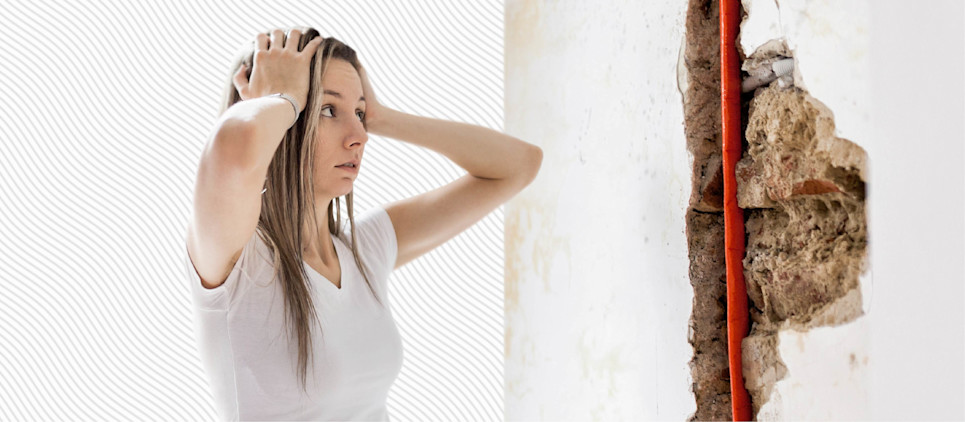Wear and tear: What tenants and landlords need to know
Few renters will leave an apartment looking as good as it did on move-in day. Some level of wear and tear is to be expected, but at what point is a tenant expected to pay for damage? Learn how landlords can protect their rental properties and tenants can get their security deposits back.

Table of contents
What does “wear and tear” mean?What is the difference between “wear and tear” and damage?Examples of wear and tear vs. damageHow to prevent landlord-tenant disputes regarding wear and tearWhat does “wear and tear” mean?
Wear and tear is a term found in most rental agreements (aka leases) to distinguish between property damage (which tenants pay for) and regular deterioration resulting from ordinary use (which landlords pay for). This clause deters tenants from damaging the landlord’s property while acknowledging that the property will deteriorate over time through no fault of the tenant.
What is the difference between “wear and tear” and damage?
Wear and tear is the result of regular use, whereas damage is the result of irresponsible actions, neglect, or accidents. Sometimes this line can get fuzzy, so it’s important to have context for the issue, including the age of the property and the tenant’s length of stay.
The length of the rental period is also important when defining ordinary wear and tear. A landlord should expect to repaint, re-carpet, and refinish floors and tubs when a long-time tenant moves out. The same would not be true if a tenant occupied the rental unit for just one year.
Examples of wear and tear vs. damage
Here are a few common examples to illustrate the difference between normal wear and tear and damage in different parts of your home.
Walls
Normal wear and tear: A few small nail holes, scratches, and scuffs on the walls. Mild discoloration of paint or wallpaper due to cooking and sunlight. In older buildings, walls may have small cracks
Damage: Large holes or dents in the walls. Drawing on the walls or unauthorized painting/wallpaper.
Floors
Normal: Some dirt and small stains on carpet. Hardwood floors may look less shiny and show small scratches or scuffs. Dirty or cracked grout.
Damage: Large stains and excessive dirt on carpet. Burn marks on carpet or hardwood floors. Large, noticeable scratches and scuffs on hardwood floors. Cracked or missing tiles.
Plumbing
Normal: Clogged pipes due to age of building and length of use. Light discoloration of taps and handles. Chipped or worn enamel on an older bathtub or sink.
Damage: Clogged pipes due to tenant misuse (flushing things that should not be flushed). Cracked or broken toilet seat, bathtub, or sink.
Appliances and fixtures
Normal: Older appliances need to be refurbished or replaced. Lightbulbs, batteries, and filters need to be replaced.
Damage: Newer appliances need to be refurbished or replaced. Fixtures or appliances are broken or missing.
Windows and doors
Normal: Windows need to be cleaned. Older screens need to be replaced. Older windows stick or crack. Doors swell, stick, or creak. Handles and knobs are worn.
Damage: Newer windows are cracked or broken. Newer screens have large holes or tears. Doors, handles, or knobs are missing.
How to prevent landlord-tenant disputes regarding wear and tear
A deep clean followed by clear communication can prevent move-out headaches for tenants and property managers alike.
Deep clean before moving out.
Once a tenant has removed the bulk of their furniture and belongings from the unit, it’s good practice for them to deep clean the space. This is the perfect time to refresh floors (both hardwood and laminate), deep clean the carpet, scrub the baseboards, and generally improve the appearance of the unit to show that the space has been cared for.
Do a walk-through before and after moving out.
The landlord or property management should walk the tenant through the rental unit before move-in day to note any existing damage. Both parties should document the state of the unit in writing and photos. This is also a great time for the landlord or property manager to let the tenant know about their expectations and tips for maintaining the property. A move-out walk-through will prevent any big surprises.
Communicate in writing about repairs.
Conducting repairs is the responsibility of the landlord, and neglecting those repairs can cause damage that the landlord may be responsible for covering. If you’re a tenant, you should alert your landlord or property manager about any type of damage the moment it happens (otherwise, it might become your responsibility).
Be specific about the security deposit.
As move-out day approaches, set a timeline for the walk-through and return of the security deposit. (This is also a good time to discuss the method of return.) If you’re a landlord and need to retain all or part of a security deposit due to damages, create a detailed document outlining all of the damages and the estimated cost of repair for each. Clear, photographic evidence of damage and reasonable estimates will decrease the likelihood of a tenant dispute.
Bungalow offers tenant placement and property management services that keep your property fully occupied and well managed—helping you earn more rental income from your investment property. With Bungalow, homeowners earn up to 20% more rental income. Learn more about Bungalow.
Ready to find your next home?
Move-in ready homes and a built-in community so you can feel at home, together — wherever you are.
Suggested articles



